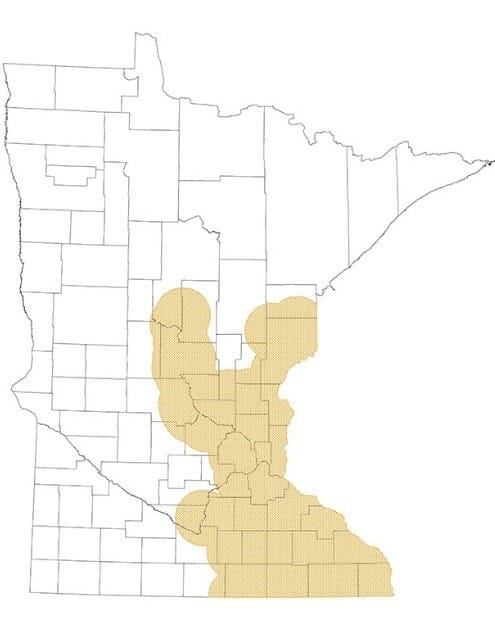*It is best to avoid ALL pruning during the growing season- mid April to late October.*
Oak Wilt is a vascular disease affecting all species of oaks found in Minnesota. It is caused by the fungus Ceratocystis fagacearum and spreads below ground via root graft transfer and above ground by nitidulid picnic beetles and possibly oak bark beetles.
Below is a map of the current range of Oak Wilt in Minnesota.
 Symptoms of Oak Wilt:
Symptoms of Oak Wilt:
- Leaf browning starts at leaf tips and margins and progresses inward towards the midrib.
- Leaf drop will occur, more rapidly and extensive in Red Oaks. Many leaves on the ground may be green or only partially wilted. White & Bur oaks experience less, and slower drop.
- Sapwood discoloration. Gray-brown to black streaks can be found in the outer annual rings of the sapwood.
- Visible symptoms in leaves appear from the top down, and outside in. Upper and outer most tips of branches wilt first.
- Symptoms usually occur mid-summer and progressively get worse.
White Oak Family (rounded lobs) Red Oak Family (pointed lobs)
Red Oak Family of Minnesota
Northern Red (most common and widespread), Northern Pin, Black Oak (southeast)
- Red Oaks are much more susceptible to Oak Wilt and will die from it. Usually showing symptoms within 3 weeks and completely wilted by 6 weeks.
- High value Red Oaks in oak wilt's current range should be preventatively protected by a fungicide injection every two years.
- Once individual trees show symptoms, they cannot be saved.
- Infected red oaks adjacent to healthy red oaks should be isolated by trenching, to sever root grafts. Adjacent red oaks should be treated as soon as possible.
White Oak Family of Minnesota
Bur Oak (most common and widespread), White Oak (southern half), Swamp White Oak (southeast)
- White Oaks are less susceptible to Oak Wilt than Reds.
- They can sometimes live years after being infected.
- They can be therapeutically treated with a fungicide injection if done before the tree reached approximately 30% canopy loss.
- Infected trees take longer to treat because xylem vessels may be occluded.
- High value trees in oak wilt's current range should be preventatively protected by a fungicide injection every two years.



